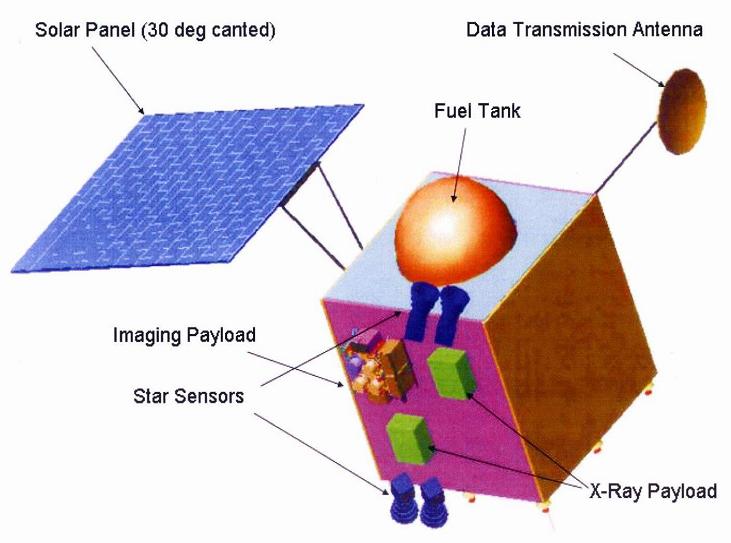A spacecraft named LCROSS fired a 2-ton rocket casing into the heart of darkness on the moon early Friday morning, blasting out two fresh craters inside a larger one in search of hidden reservoirs of water.
The impact did not send the high plume of moon rocks and dust into the sunlit lunar sky as scientists had expected, but instruments aboard the spacecraft did record a sudden bright flash of light and the spectral lines of sodium and other as yet unidentified chemicals.
It also appeared that as LCROSS soared over the first new crater, it flew right through a high plume of vapor from the impact, mission scientists said.
"The spacecraft flew beautifully," said Anthony Colaprete, the LCROSS mission's chief scientist. "We saw the crater, we saw the flash and we looked deeper and deeper into the crater's shadow, but if there's water there, we'll have to see what the data tells us."
Like every NASA venture into space, the ultimate success of this one will be known after all the instrument data is analyzed. And there's plenty of it, for the Hubble Space Telescope and five other orbiting spacecraft from Japan, India and the U.S. were all training their instruments and optics on the event. Telescopes at 20 major astronomical observatories from New Mexico to Hawaii were also part of the mission's observing campaign.
Precision navigation
The flight itself was a remarkable feat of precision space navigation by engineers and scientists at the NASA Ames Research Center in Mountain View, where the mission was designed, built and controlled. And it gave the scientists their first-ever chance to explore material that has lain hidden beneath the moon's surface for billions of years.
At 7:30 p.m. Thursday LCROSS - the Lunar Crater Observation and Sensing Satellite - aimed its Centaur rocket casing at the target deep inside a lunar crater 60 miles wide named Cabeus. So precise was the mission control team's aim that the Centaur hit just about 1,500 feet from the exact center of its 12-mile-wide assigned spot, and it dug an impact crater that may be 60 feet wide and 13 feet deep.
And when the brilliant plume failed to rise from the permanently shadowed crater, Michael Bicay, science director at the Ames center, speculated that the Centaur might have hit solid bedrock rather than the mix of smaller rocks and sand the scientists had expected.
Colaprete, however, suggested later that the debris from the crash might have spread out widely inside the shadow instead of rising above it - depending on its composition.
The predicted impact time was 4:3o a.m. Friday, and it came only one minute later, after LCROSS controllers, led by project manager Daniel Andrews, sent the Centaur rocket speeding to the target from 25,000 miles away at 5,580 mph. It was quite a piece of tricky space navigation.
After the Centaur's impact, LCROSS, its "shepherding satellite," was less than 375 miles above the moon's surface. And four minutes later the LCROSS satellite itself plunged on schedule into the same wide crater to make a smaller impact crater of its own.
Cabeus, the broad target crater, lies just above the moon's South Pole, where for 10 years scientists have been seeing evidence that rich deposits of hydrogen lie there - either as hydrogen alone, or as molecules of hydrogen and oxygen known as hydroxyls -or better yet, as deeply frozen water ice that has remained solid for billions of years in craters that have never seen any light at all.
Where's the water?
And that's precisely what this mission has been all about: to find out whether immense quantities of water do in fact lie beneath the moon's dry and lifeless surface. The moon has been bombarded ceaselessly by meteors and comets ever since it formed, and since comets typically contain large amounts of water, mission scientists reason that water indeed should be detected when they finally analyze the mountains of data from all the instruments in orbit and on the ground.
"There's water down in that crater, and we're going to dig some of it up," Colaprete had said at a newsconference Thursday. And on Friday, without speculating, he still insisted the odds are good that the cryptic data will ultimately show there is water on the moon.
LCROSS was launched from Cape Canaveral in June as a kind of hitchhiker aboard another spacecraft called the Lunar Reconnaissance Orbiter, and the LRO has been orbiting the moon ever since on an independent mission to map the moon's entire surface. It was flying right over the impact sites Friday and will continue gathering data from them on every orbit.
Ames officials had opened the guarded space center to the public on Thursday, and hundreds of space enthusiasts gathered in the frigid open for the night, entertained by free moon movies, informed explanations, and images of the LCROSS experiment projected on a giant screen.
When the debris plume was barely visible instead of spectacularly bright, the crowd - with some in sleeping bags and tents - was disappointed and many grumbled.
"It was fun to hang out with my friend Dylan, but it's kind of like I got up at 3 in the morning for nothing," said Bobby Howie, 9, of San Mateo.Read more:
 NASA astronaut Edward Michael Fincke on Friday said the Indian moon mission 'Chandrayan' was not a failure, but an "amazing success".
NASA astronaut Edward Michael Fincke on Friday said the Indian moon mission 'Chandrayan' was not a failure, but an "amazing success".




